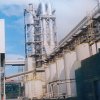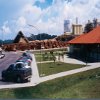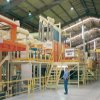Sonae is here to stay
19 August 2005Despite economic uncertainties in Brazil, a row with its local business partner and a lack of its own forest reserves in the country, Sonae Group’s long term commitment to its Tafisa Brasil panel subsidiary is said to be “not in doubt”.
For some time, rumours have been rife within the Brazilian panel industry and beyond that Sonae, in spite of sinking US$270m into the firm, was ready to sell Tafisa Brasil.
At one point late last year, the firm was quoted in a leading Brazilian newspaper as stating that there was no ‘For Sale’ sign on the Curitiba-based MDF, particleboard and flooring producer.
Now, Tafisa Brasil’s chairman and chief executive José Baeta Tomás has firmly scotched the rumours. “Sonae’s position in Brazil is not in doubt with any of its businesses,he emphasised.
Sonae’s panel joint venture with Canadian group Brascan Corp is finally delivering good returns as it consolidates its position in a crowded panel market, he insisted.
“We are in a good phase in terms of increasing our profitability and that has been done within not such easy market conditions, because there is over capacity [in Brazil],Mr Tomás told WBPI’s Richard Higgs in an exclusive May interview at the Tafisa Brasil panel complex in Piên, Paraná state.
The emphasis on improved margins is in line with the strategy of the firm’s ultimate Portuguese parent group, Sonae SGPS SA, which demanded a financial payback following years of heavy capital investment, particularly in its industrial operations worldwide.
Brazil, where it also owns significant retail property development interests, is the country which has received Sonae’s greatest investments outside Europe, said the executive. Back in 2002, parent group president Belmiro de Azevedo stressed Sonae was calling a halt to a string of major project investments still planned at Tafisa Brasil. It was time to cut costs, improve profitability and focus on selling added value products, he told WBPI on a visit to Brazil that year.
Among ambitious spending schemes to bite the dust at Piên since then were plans for a 50 million m2/year panel painting and lacquering line; a new mouldings plant and a 150,000m3/year sawmill, capable of supplying more than 40% of the panel plant’s raw material needs.
“We decided as a group, not only the industrial side, to consolidate our investments in this country in order to define later on, a new wave of growth, if that is feasible in terms of the economy,said Mr Tomás, a Portuguese who took charge of Tafisa Brasil a year and a half ago.
Since 2002, the Brazilian panels operation has seen a significant shake-up in both its senior management and workforce. Management changes saw the departure of industrial project manager Jose João Lobo and chief executive Edson Ungarelli, the arrival of a new operating team and a reduction in labour of some 200, the firm said.
There is still much to do in terms of consolidating Sonae’s Brazilian manufacturing investment and this phase of development is likely to continue for Tafisa Brasil for up to three more years, according to Mr Tomás.
The company’s 56ha site features a 252,000m3/year Siempelkamp ContiRoll particleboard line; two ContiRoll MDF lines, with combined capacity of 384,000m3/year; three overlay press lines for melamine and finish foil; a six million m2/year robotequipped laminate flooring unit; a highspeed, low-cost sanding centre and comprehensive automated Giben cutting centre.
There is no doubt that back in 1997 when Sonae Tafisa first launched its Brazilian wood panel operation, it had its eyes fixed firmly on the country’s huge potential market. However, what is now clear is that Tafisa Brasil’s joint shareholders have found the going in Brazil, with its economic ups and downs and Third World lack of infrastructure, a lot tougher than expected.
“Both shareholders hoped that the return [from the project] would have been quicker than it has been,admitted Mr Tomás. He blamed difficult economic conditions in Brazil over the last few years for poorer results than Sonae group, in particular, had expected.
The Tafisa Brasil project, with Sonae Tafisa now holding a 63% stake and Brascan 37%, originally saw the Tafisa panel complex being fed primarily by pine plantations, in Paraná and Santa Catarina states, owned by Brascan Brasil SA.
As the complex’s panel capacity expanded – today, it consumes almost 3,000 tons of wood per day – it has relied more and more on buying sufficient raw material on the open market. Today, only around 10% of its needs come from Brascan’s forests, according to Mr Tomás.
It is public knowledge that relations between the companies’ shareholders have not been good. There has been disagreement over a number of issues, including the supply and pricing of wood and how management of the Tafisa Brasil mill operation should be shared, admitted Mr Tomás, although he was reluctant to go into details of the dispute.
“The difficulties between the partners were never completely connected with the wood supply....because the wood reserves Brascan had were and are not enough to supply us.
“I think the discussions are in terms of how the share of management of the [joint] company should be, even though that is regulated by the shareholder agreement, and that led to difficulties,he suggested. He admitted that the running dispute created “not a very good image in terms of the reliability of the company”.
Mr Tomás conceded that comment about Tafisa Brasil has centred on two issues – its lack of forest plantations and the shareholder problems. But, the chairman stressed, the row “did not prevent us from operating in the market. I never experienced difficulties with clients for that reason...in the end, [selling] is down to your quality and price,he declared.
In any event, he added, partner relations are “beginning to improve, and I hope that will happen”. He expressed confidence a solution to the problem would be found “in time”.
In an environment where cost cutting has become an imperative, Tafisa Brasil is only too well aware of its weakness in the forestry area.
In common with the rest of Brazil’s wood panels industry, Tafisa Brasil is facing the effects of a national wood shortage. This stems from a period of five to eight years in the 1970s and early 80s when government forestry incentives ceased and thus little tree plantation took place nationally. Planting recovered, without big state incentives, when wood industry growth boosted demand again, confirmed Tafisa.
Since then, however, for those who rely on wood as their base raw material, prices have generally soared in the market. This has come as a blow to Brazil’s panel makers, struggling to lower production costs in their own highly competitive marketplace. Producers like Tafisa Brasil, without forest reserves, are particularly vulnerable in the open market and are having to optimise still further their use of raw material.
Already, the Piên mill has increased substantially the level of waste fibre it uses in its particleboard up to as much as 60% – more than other producers, it claims. It has intensified its search for better quality waste material and improved sources of supply, according to Piên industrial director Mário Gavinho.
In addition, Tafisa Brasil has increased the amount of eucalyptus wood fibre it adds to its panels with a maximum today of between 10%-15% of the total fibre mix, explained Mr Gavinho, former project manager at the Placas do Paraná MDF scheme, who started at Piên in 2003.
But, he warned, even more optimization will be required with the prospect that wood prices will go still higher as big wood suppliers trade heavily on the current scarcity.
Earlier this year the panel maker was able to stock up its 85,000 ton woodyard to benefit from a short-term rise in lower priced material. This was available as small wood processors, hit by the dollar/real exchange rates, bought in less.
When WBPI visited Piên in May, two giant columns of trucks, bulging with pine logs, lined the highway outside the complex in both directions, waiting to drop their loads. This was prior to a public holiday, according to the firm.
The company, after expanding its limited portfolio of added value products in the market, is putting great emphasis on trying to boost sales of these lines, including laminate flooring. “We have a very small share, even nowadays, in that area [added value], so we think we can improve it,said Mr Tomás. Last year, the firm turned out 4.4 million m2 of melamine-faced board and 1.7 million m2 of finish foil covered panels, it said.
In the panel business, Tafisa Brasil has seen its share of the market reduced more recently. This is a result of major newcapacity projects, especially MDF, coming on-stream within the last two years, said the chairman.
“We are maintaining our volumes, but basically, in terms of share, ours is lower than it was at the beginning obviously, because there were less players then,”Mr Tomás told WBPI. In 2003, figures issued by the Brazilian wood panel producers organization ABIPA showed that Tafisa Brasil contributed just 8% of the country’s particleboard capacity, but around 28% in MDF.
The Brazilian panel market generally is currently growing at an average rate of 12% to 15%, although recent years have witnessed clear differences in trend between MDF and particleboard.
In 2003 MDF consumption grew faster while particleboard remained almost static, whereas last year the trend reversed, with particleboard sales up strongly and MDF down, said Mr Tomás.
Tafisa Brasil’s chairman put the sudden 2004 upswing of particleboard down to the gradual entry of poorer Brazilians into the panel furniture market. Because of their low income, only the less expensive particleboard goods were within their range.
Looking ahead, he suggested that, with the national economy unlikely to repeat last year’s high rate of growth, the panel market is set to remain stable over the next few years. “I don’t expect spectacular growth,he said. The consolidation phase at Tafisa Brasil has been characterised by a programme of improvement in operating the existing plant facilities. “We need to continue to work here with what we already have,stressed Mr Gavinho.
In its quest for greater productivity, the Piên plant is continuing to carry out a degree of fine tuning on its processes and equipment. This involves a number of lowcost projects to raise efficiency and increase the value of Tafisa Brasil products.
“We are working on [improving] a lot on things like press time and availability of the lines,explained the industrial director.
One urgent project is the addition of a secondhand 75 tonne/hour wood chipper, being brought from a Tafisa plant in Spain. With its existing 100 tonne/hour unit needing major maintenance, daily stoppages have been costly.
These have forced the firm to buy in 300-400 tonnes of chips per day, the equivalent of up to 15% of its daily needs, according to plant engineering coordinator André Luis Silva. “The chipper is not working properly and we are not getting 100 tonnes of chips per hour. It has to stop three to four hours per day for maintenance,he explained.
Another area where operational problems have had to be addressed, he said, is in the particleboard line chip preparation. Again maintenance downtime was high and the plant has just completed a project to change the layout, parts of the piping and electrical systems to resolve the difficulties.
In addition, with exports rising, the plant plans to install a fourth panel packing line just for those shipments destined for foreign customers. Making use of existing equipment on site, the firm wants to pack export products more securely to deal with cases of damage sustained in transit.
In terms of line productivity, Tafisa Brasil managers have set themselves an overall target of reaching output of 55,000m3/month on all three panel lines by the end of 2005. In May, production was running at between 46,000-47,000m3/ month, confirmed Mr Silva.
Beyond Brazil, things are also looking up for the group’s industrial division, Sonae Industria, which over the past two years has seen “a big turnaround”. It had taken time to digest its major European acquisition of Glunz, which is now helping make the division “a large contributorto improved group results, Jose Tomás pointed out.
With a fresh plant team and management already tackling some formidable challenges, and Sonae’s backing assured, it remains to be seen if Tafisa Brasil can deliver the goods in the tough Brazilian panel market.



